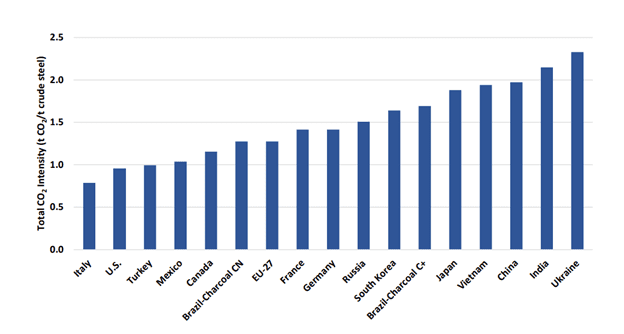Stop Using ‘Dirty’ Steel for Renewable Energy Projects
As the solar and renewable energy movement continues to gain momentum in the U.S., it’s important to note how critical the steel industry is to the renewable energy industry. In fact, reports show that steel comprises more than 70% of the weight of a typical wind turbine and each new megawatt of solar power capacity requires between 35 and 45 tons of steel.
Steel is used in many ways on renewable energy projects, including:
- Torque tubing is the main structural support for tracking systems.
- Round and rectangular steel tubing is used throughout the solar industry as support piers for ground-mounted applications. Steel tubing and plate are used to manufacture screw piles designed to meet a variety of demanding soil conditions and requirements.
- Beyond solar-specific applications, steel products are also used for perimeter security fencing (posts, fabric and framework) as well as electrical conduit.
COMMENTARY
So yes, the renewable energy industry is closely tied to the steel industry, working together to create a better environment for us all. And yet, one of the biggest ironies is that much of the steel used in solar applications is sourced from overseas manufacturers and adds a dirty element to what’s supposed to be a clean energy project.
Environmental Impact of Imported vs. Domestic Steel
When approaching any project (solar or otherwise), it’s important to understand and measure the environmental impact, or embodied carbon, of each material used. This includes every step in the journey of the material, from manufacturing to transportation, waste, and recycling. Since steel is infinitely recyclable, it’s arguably the greenest product on the planet from that perspective. However, when you dive into the manufacturing and transportation processes, it’s clear that domestic steel provides significant advantages over imports.

Global Efficiency Intelligence issued a Steel Climate Impact report that benchmarked the energy and carbon dioxide intensities of the largest steel-producing countries. The report shows that the U.S.–the fourth-largest steel-producing country–produces the second-cleanest and lowest-carbon steel in the world.
Beyond the manufacturing output, transportation via container ship is terrible for the environment. Large cargo ships can burn up to 63,000 gallons of fuel per day and emit approximately 5,200 tons of sulfur oxide pollution annually. That means that just 15 large ships now emit as much sulfur oxide as the world’s 760 million cars. When the CO2intensity of shipping is considered, it becomes crystal clear that all steel used in the solar industry should be made in the USA.

Of the largest six steel-producing nations (China, India, Japan, the U.S., Russia, and South Korea), only the U.S. is on the lower half of the intensity chart. Notably, China–the world’s largest steel producer–has a total carbon dioxide intensity (per ton) that is double that of the U.S.
These results are the direct result of the U.S. focus on greening the steel production process. According to the American Iron and Steel Institute, producing a ton of steel today in North America requires less than half the energy that was needed to produce a ton of steel 40 years ago, resulting in a 50% reduction in greenhouse gas (GHG) emissions. This means that a single ton of steel produced today, compared to 1980, would save the GHG emissions equivalent to driving a car for 2,000 miles. The American steel industry has been nationally recognized for its energy efficiency and greenhouse gas emission reductions by the U.S. Environmental Protection Agency and the U.S. Department of Energy.
Social Impact of Imported vs. Domestic Steel
In addition to the challenges noted above, there are also societal impacts to consider when choosing imported steel versus a domestic product. As is the case in many industries, when buying from overseas, renewable energy developers have no way of ensuring that the steel was manufactured ethically.
First and foremost, the U.S. has strict laws that govern the wages paid to steel workers, and a strong track record of human rights and fair treatment of employees. These laws seek to create the safest working environments and that no employee is overworked and underpaid. On the other hand, it can be difficult if not entirely impossible to verify the treatment of steel workers in China, India, and other leading steel-producing countries. Turning a blind eye to potential human rights abuses in the name of saving a few dollars puts a substantial stain on an industry whose goal is creating a better world for all.
Although social impact is not a factor that tops the consider set for most buyers, there is a real financial benefit to it as well. Dollars spent domestically on U.S.-produced steel generate tax revenue that flows back into the local economy at federal, state and community levels. When considering sales and income taxes, Zekelman Industries has estimated this impact to be approximately $500 to $600 per ton of steel pipe and tube sold.
Specifically for the renewable energy sector, the Inflation Reduction Act (IRA) has further incentivized developers to purchase from domestic suppliers. Many of the clean energy tax provisions include a 10% bonus credit if the project meets certain domestic content requirements for steel, iron, and manufactured products.
In short, measuring the social impact of your steel decisions goes beyond the manufacturing process itself, looking at how well companies treat their employees and the impact on your community and your bottom line. In many cases, the “savings” created by buying cheap, imported steel are easily offset through incentives and local impact.
The Bottom Line
When American companies–especially those in the renewable energy space–continue to turn to China and other foreign countries for steel, it adds a needless and dirty element to what is supposed to be a clean industry. In addition to significantly worse environmental impacts from manufacturing and transportation, imported steel purchases is literally taking money out of the American economy and giving it to countries with far worse social records.
To make the greenest install, all components used in the project should be traced back to the source. And when that exercise is complete, you’ll see the only solution to cleaning up the renewable energy is by sourcing domestically made steel products.
—Tom Muth is executive vice president and chief operating officer for Zekelman Industries.